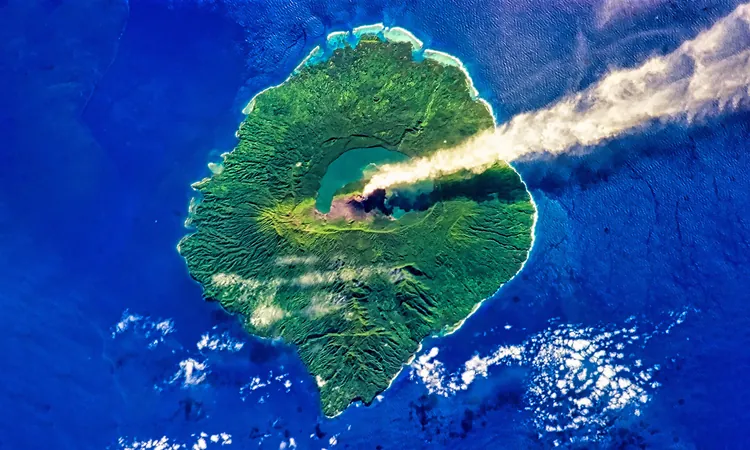
How Plants Could Be the Key to Predicting Volcanic Eruptions
2025-01-05
Author: Chun
Rethinking Volcano Monitoring
Traditionally, volcanic activity has been monitored through seismic activity and gas emissions. However, these methods can overlook subtle precursors hidden beneath rugged terrains, particularly in remote areas where access is limited. Researchers are now exploring unconventional techniques that utilize vegetation as vital indicators of geological activity.
The Role of Carbon Dioxide
One of the significant gases released by volcanoes is carbon dioxide, which is often emitted as magma rises. This gas is also prevalent in everyday life, making it challenging to isolate volcanic signals. Therefore, teams are creatively examining plant health to gauge changes below the Earth's surface.
A notable research project led by Robert Bogue from McGill University investigated the patterns in vegetation health near hydrothermal sites within the Yellowstone Caldera, revealing latent indicators of volcanic unrest.
Plant Responses to Geological Changes
Plants are sensitive to their environment and can exhibit a variety of physiological changes when geological factors are at play. For instance, variations in sulfur and soil temperature can significantly impact tree health and growth patterns. Scientists suspect that changes affecting vegetation may precede major volcanic events by months or even years.
One effective tool in this research is the Normalized Difference Vegetation Index (NDVI), which assesses how actively plants are photosynthesizing. By analyzing historical NDVI data, researchers can identify noteworthy trends that suggest changes in subsurface activity.
Tern Lake: A Hotspot for Research
Located in Wyoming's Yellowstone Caldera, Tern Lake serves as a fascinating case study. Between 1984 and 2022, scientists analyzed archived Landsat imagery to track changes in tree health within a hydrothermal zone. Initially, tree health improved due to nutrient influx, but a downward trend emerged in the early 2000s as unhealthy conditions began impacting the local vegetation.
Infrared data indicated extreme soil temperatures and harmful gas emissions, ultimately leading to tree die-offs. As these adverse effects spread, they revealed ongoing geological changes beneath the surface.
Unlocking Early Warning Signals
The research team linked its findings to the movement of hydrothermal fluids and the subsequent geological activity. Anomalies in seismic data further validated these correlations, suggesting that signs of unrest could precede traditional monitoring alerts.
Interestingly, recent observations have shown new seedlings sprouting in previously barren areas, hinting at a potential stabilization in the environment. This underlines that volcanic processes can fluctuate over time, complicating the predictive model.
A New Frontier in Volcanic Monitoring
The ability of plants to signal underground activity is a groundbreaking development in volcanology. While traditional monitoring methods continue to have their place, integrating vegetation-based observations could provide researchers with earlier warnings of potential eruptions.
Every volcano has its unique attributes and surrounding ecosystems, affecting how scientists can apply these techniques. In areas rich in plant life, using vegetation indexes may prove invaluable; conversely, factors like severe weather and drought could complicate the analysis elsewhere.
Looking Ahead
Scientists are refining these methods and gathering more data to enhance their understanding of volcanic behavior. This research gives hope that combining vegetation indicators with seismic activity and gas composition data can lead to more precise risk assessments.
In the not-so-distant future, such advances could enable researchers to issue eruption alerts faster than ever. As illustrated by the experience at Tern Lake, plants may act as nature's early warning system, helping to safeguard communities against the unpredictable might of volcanoes.
The full study on these findings was published in the journal *Geochemistry, Geophysics, Geosystems*, contributing to our understanding of how flora can enhance volcanic monitoring strategies.

 Brasil (PT)
Brasil (PT)
 Canada (EN)
Canada (EN)
 Chile (ES)
Chile (ES)
 Česko (CS)
Česko (CS)
 대한민국 (KO)
대한민국 (KO)
 España (ES)
España (ES)
 France (FR)
France (FR)
 Hong Kong (EN)
Hong Kong (EN)
 Italia (IT)
Italia (IT)
 日本 (JA)
日本 (JA)
 Magyarország (HU)
Magyarország (HU)
 Norge (NO)
Norge (NO)
 Polska (PL)
Polska (PL)
 Schweiz (DE)
Schweiz (DE)
 Singapore (EN)
Singapore (EN)
 Sverige (SV)
Sverige (SV)
 Suomi (FI)
Suomi (FI)
 Türkiye (TR)
Türkiye (TR)
 الإمارات العربية المتحدة (AR)
الإمارات العربية المتحدة (AR)